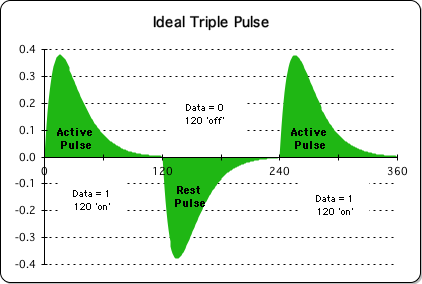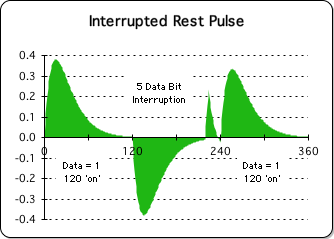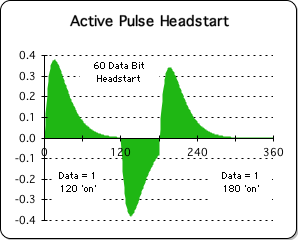Section Headings
- The Triple Pulse: Sleep & Cognition
- Does Life attune to Energy Patterns of Data Stream Dynamics?
- Why Evolution might link Pleasure & Pain to Info Forms
- Why Pleasure could be linked to Intrinsic Motivation
Intrinsic Motivation (IM), the so-called 3rd drive, is a powerful internal drive that motivates us to solve problems independent of external factors, such as rewards or biological needs. Some claim that it is the driving force behind the creative process. There are many mysteries associated with IM.1.
The exclusively materialistic perspective (molecules, electrons and brain scans) is impotent before these questions. No explanatory power. In contrast, when viewed as a function of our Information Digestion system (ID system), the answers to IM’s mysteries pop out at us. Let us examine the questions and our proposed answers.
Question 1: If not extrinsic, what system gives rise to this intrinsic drive? IM could easily be a function of our information digestion system. Why? They share a common process (engaging with data streams) and similar components (a synergy surrounding Attention)2.
Question 2: Why, do If-Then conditional rewards actually inhibit, rather than enhance, the creative potentials of this 3rd drive? Splitting Attention between problem-solving and rewards diminishes our level of concentration. In turn, diminished concentration inhibits our ability to solve problems. This analysis is supported by a mathematical feature of our ID system - the Pulse3.
IM has two other mysteries that have yet to be addressed.
Question 3: Why does absolute autonomy enhances the 3rd drive? Why does freedom enhance this creative process?
Question 4: Why is the IM process one of the most satisfying experiences that humans have? Why is this type of play so enjoyable?
Our ID model provides a reasonable explanation for the first two mysteries. Can the notion of an independent information digestion system shed some light upon the other two mysteries of Intrinsic Motivation? Can this model reveal why personal autonomy is so vital to the expression of the 3rd drive? Can it provide a plausible reason for why IM is so enjoyable?
The Triple Pulse: Sleep & Cognition
We introduced the Pulse of Attention in order to understand the relationship between rewards and IM. Splitting Attention diminishes the ideal dimensions of the Pulse.
Rewards Bad, Autonomy Good & Evokes Joy
Let us examine yet another way in which the ideal dimensions of the Attention Pulse are diminished. The Pulse is part of a larger data stream deemed the Triple Pulse. The Triple Pulse is so called because it consists of ‘positive’ Pulse, a ‘negative’ Pulse, and then another ‘positive’ Pulse, in that order. Below is a graphic realization of this process.

An alternation of ‘Positive’ & ‘Negative’ Pulses
As mentioned, when the Living Algorithm digests a number string of 1’s of sufficient duration, one of the results is the Pulse. When a number string of 0s of sufficient duration follows the string of 1s, one of the results is a ‘negative’ Pulse. When a number string of 1’s of sufficient duration follows the string of 0s, the digestion process yields another positive Pulse. The negative and positive Pulses have identical dimensions, except inverted.
Pulses mutually dependent for existence
With the appropriate number strings, this alternation of positive and negative Pulses could continue indefinitely. Note, however, that the number string of 0s only generates a negative Pulse, if it follows a number string of 1s of sufficient duration. Similarly, the number string of 1s only generates an ideal Pulse if it follows a number string of 0s of sufficient duration. In other words, the Pulses are not independent, but are instead mutually dependent upon each other for their very existence.
Triple Pulse, a metaphor for Sleep-related behavior
Due to the many patterns of correspondence between sleep-related behavior and the Triple Pulse, this fundamental mathematical form of the information digestion process provides a plausible model for the Sleep/Wake cycle. In this context, we refer to a positive pulse as an Active Pulse, and a negative pulse as a Rest Pulse. In terms of our model, the Active Pulse corresponds with the Waking State, and the Rest Pulse corresponds with Sleep.
Interrupted Rest Pulse diminishes the Pulse dimension
Mathematically, interruptions or shortening the Rest Pulse detracts from both the area and height of the subsequent Active Pulse. In simpler terms, tampering with the Rest Pulse shrinks the following Active Pulse (shown in the following graphs).


Sleep Deprivation diminishes cognitive abilities
If the Triple Pulse does indeed provide an effective model, then Sleep Deprivation should have a negative impact upon our Waking State. Experimental evidence validates the prediction. Indeed interruptions to our sleep cycle have been shown to detract from mental performance. As predicted, Sleep Deprivation does have a negative impact upon our cognitive abilities. As one researcher put it, ‘Sleep loss equals mind loss’. What is the root of this mysterious relationship between Sleep and cognition?
Attention ‘on’ when awake and ‘off’, when asleep
In terms of our model, Attention is ‘on’ when we are awake/conscious, and ‘off’ when we are asleep/unconscious. When Attention is ‘on’, we both take in and digest information. When Attention is ‘off’, we don’t take in any more information. When asleep, we are able to finish digesting the information taken in while awake. In similar fashion, the stomach requires down time to finish digesting food.
An incomplete digestion process compromises our ability to concentrate Attention?
Could it be that when Sleep is interrupted that the information digestion process is compromised? Is it then possible that an incomplete digestion process compromises our ability to focus? Does this undigested info interfere with our ability to concentrate Attention? This is certainly what Triple Pulse mathematics indicates.
Does Life attune to Energy Patterns of Data Stream Dynamics?
Parallels between LA and Attention?
What is the reason for the striking parallels between the LA’s mathematical forms (the Pulse and Triple Pulse) and Attention?
Attention -> LA -> DSD -> Forms
Our model suggests that human Attention digests information via an image overlay process The Living Algorithm (LA) is the mathematical realization of this process. The LA generates a mathematical system, i.e. Data Stream Dynamics (DSD). DSD contains some innate mathematical forms, notably the Pulse and Triple Pulse.
Life’s best interest to attune to innate Forms as most efficient?
What if it were in Life’s best interest to attune to these natural forms as the most efficient method of digesting, organizing and responding to environmental information? If these mathematical forms are indeed the most efficient, then there should be some examples of biological systems attuning to these natural digestion rhythms.
Examples: Sleep, Posner’s Attention Model, Dement’s Opponent Process Model, Neural Networks
The Sleep/Wake cycle is a good example of living systems taking advantage of the natural Triple Pulse cycle. Other articles have provided evidence suggesting that both Posner’s Attention Model and Dement’s Opponent Process Model regarding the biology of sleep could easily be taking advantage of other mathematical features of Data Stream Dynamics. Further the timed repetition required to change neural networks that is the key to memory retention also mimics the uninterrupted repetitions necessary to generate the ideal Pulse.
Examples provide evidence of Evolutionary processes choosing these forms
These significant examples provide support for the notion that living systems take advantage of DSD’s natural mathematical features. They also illustrate that biological forms might actually evolve to better attune to these energy patterns, i.e. forms, as the most efficient method of employing digested information to interact with the external world. Could it be that evolutionary processes, i.e. natural selection combined with genetic mutation, chose to ride the wave of these specific shapes because they enhanced the possibility of survival?
Why Evolution might link Pleasure & Pain to Info Forms
Did Emotions evolve to encourage use of innate Living Algorithm forms?
As an early evolutionary tool, emotions were frequently linked to effective processes as a means of encouraging their use. For instance, the pleasure of sex is tied with the essential need for procreation in order to further the species. Let us suppose that DSD’s forms do provide an evolutionary advantage. If so, then emotions should have evolved to encourage the use of these innate mathematical energy patterns. Is there any evidence that supports this perspective?
Pleasure with Uninterrupted Pulse; Pain with Interrupted Pulse?
Let us suppose that the execution and completion of an uninterrupted Pulse of information digestion maximizes the assimilation and integration of information. If so, then natural selection would have probably linked pleasure with the process. Conversely, mental pain would be associated with interruptions to this same Pulse due to the negative impact.
Evidence: Personal agitation over Interruptions to Creative Sessions
Let us look at some anecdotal evidence for this perspective. One of the early motivations for the development of DSD was the author’s curiosity concerning the mental agitation he experienced when a phone call or visitors interrupted one of his creative sessions. His investigation ultimately led to the ‘discovery’ of the Pulse, or what he then called the Creative Pulse.
Universal Evidence: Human Anger at Interruptions to Performance
On a more universal human level, it is undeniable that interruptions to a performance of any variety frequently evoke anger in the audience, musicians, actors, and/or lecturers. Indeed we even have established rules to prevent this occurrence. What does this anger represent? Is it because these humans are neurotic? Or is it because distractions inhibit the pleasure associated with the uninterrupted Pulse of Attention required for an ideal Experience? Could it be that the anger is proportional to the anticipated pleasure?
Pleasure & Pain linked to Pulse
From these examples, it certainly seems plausible that both pleasure and pain are linked to the Pulse, one to encourage its completion and the other to discourage interruptions. Why? A sustained Pulse of Attention is required for the quality Experience associated with insight and integration, at least according to our mathematically based model.
Pleasure connected to the Triple Pulse Cycle due to the importance of Sleep
Not only does pleasure seem to be associated with the completion of the Pulse, it is also seems to be linked to the Triple Pulse cycle. Just as we are happy to experience our daily Pulses, it also gives us happiness to collapse in bed after a long day. In this case, pleasure is associated with the ‘negative’ Rest Pulse due to its importance in refreshing the ensuing ‘positive’ Active Pulse. Conversely, note how irritated we become when our Sleep cycle is interrupted prematurely.
‘let sleeping dogs lie’ indicative of pain of interrupted Sleep
The expression ‘let sleeping dogs lie’ is yet another indication of the pleasure of sleep and the pain associated with premature interruptions. The phrase is based around the danger associated with interrupting a dog’s slumber. A normally peaceful pet might snap in anger at the offender, presumably due to irritation concerning the premature halt to the enjoyable sleep cycle. If the completion of this cycle were unimportant, interruptions would not evoke such a strong emotional response.
‘Until death us part, but not for lunch.’ Pain & Pleasure of Triple Pulse of Relationships
The importance of the Rest Pulse for maintaining positive emotions is also indicated by the common expression – ‘Absence makes the heart grow fonder.’ It is evident that couples require separation from each other to refresh the relationship. Indeed another expression expresses the converse emotion – the pain of too much time together – ‘Familiarity breeds contempt.’ ‘Until death us part, but not for lunch,’ is yet another expression that indicates the pleasure associated with a long-term partnership and the pain associated with too much time together. Parents also require a break from their children to love them more. It seems again that evolutionary mechanisms have linked both positive and negative emotions to the Triple Pulse information digestion cycle, this time with regards to relationships.
Why Pleasure could be linked to Intrinsic Motivation
Having laid the groundwork, we can now tackle the remaining mysteries associated with Intrinsic Motivation. First, why is pleasure associated with IM?
Could pleasure be linked with the accumulation of information due its importance for survival?
Our examples indicate that emotions are connected to the mathematical patterns of Data Stream Dynamics. If emotions are indeed linked to these mathematical forms, it seems equally likely that evolutionary forces would also associate pleasure with the accumulation of information.
Why? Information is the food, the sustenance for the information digestion system associated with DSD. Just as we have an appetite for food, we should also have an appetite for immaterial information.
Dopamine excreted when we accumulate information
Indeed this is so. Dopamine, a pleasure-inducing hormone, is excreted when we merely accumulate information. Some cognitive scientists claim that this is one of the motivations for surfing the Internet. With each new burst of information, there is a little rush of happiness. This pleasure could easily be the root of curiosity.
No assimilation of Information when Attention constantly shifting
However, curiosity by itself is not sufficient. Experimental evidence indicates that information is not assimilated very well when Attention shifts rapidly from topic to topic. According to our information digestion model, this is due to the simple fact that Attention has not been sustained on a topic for a sufficient duration to have the Experience required for insight and integration. When the Pulse is aborted prematurely, the quality of the Experience suffers. This is the flaw of Shifting Attention.
Individuals that focus Attention long enough to assimilate information more likely to survive.
It seems likely that evolutionary processes provided dopamine to encourage us to accumulate information. However without assimilation, this knowledge is virtually useless. Those afflicted with constantly shifting Attention would be less able to digest and integrate information. With less knowledge accessible to them, it seems that they would also be less likely to survive to pass on their gene pool. In contrast, individuals who regularly sustained their Attention on a singular type of information for a sufficient time period would assimilate knowledge. In turn, they would be able to employ this digested information to facilitate survival. Their gene pool would be passed on.
Could Pleasure be linked with completing the Pulse of information integration?
Further those individuals who actually derived some pleasure from sustaining Attention on information long enough to have the experience of integration would regularly participate in the completed information digestion process. Every time they completed this Pulse of information assimilation they would accumulate and integrate more knowledge. This knowledge would probably enhance the possibility of survival into adulthood. In this fashion, they would pass on the gene pool that linked biological pleasure with the Pulse of information integration.
Pleasure > Pulse > Info Integration
It certainly seems plausible that this Pulse of information integration has its roots in the Living Algorithm’s digestion process. This provides another example of pleasure being tied to the Pulse, one of the mathematical forms of Data Stream Dynamics.
Could Pleasure be associated with Problem Solving?
It seems that biological pleasure is linked to information accumulation and could easily be linked to completing the information digestion cycle. However, just as curiosity is not enough, integrating information is also incomplete. The integrated information must be employed to solve problems for it to actually provide a survival advantage.
Evolution links pleasure to Problem Solving
Individuals that enjoyed both accumulating and assimilating information, and also enjoyed solving problems with this info would probably survive more frequently to pass on their gene pool. In other words, evolutionary processes would most likely choose problem solvers. Because problem-solving skills improve with use, could it be that biological pleasure would also be linked to performing heuristic tasks to encourage practice?
IM’s Triple Pleasure: Info accumulation, Info integration, Problem solving
Could the pleasure associated with info digestion be the motivating force behind the 3rd drive, Intrinsic Motivation? If so, there are three types of positive reinforcement associated with the process. First, we get pleasure from info accumulation (dopamine). Second, integrating the information via a completed Pulse evokes happiness. Third, evolution probably associated pleasure with actively engaging with the integrated information, i.e. problem solving independent of results. This triple pleasure could be why participating in the IM process is so ultimately satisfying. Could this triple pleasure5 be why participating in the IM process is so ultimately satisfying?
Footnotes & Other Articles in the Series
1 4 The Mysteries of Intrinsic Motivation, 2020
2 Why Intrinsic Motivation belongs to Life’s Information Digestion System, 2020
3 Why Rewards inhibit Intrinsic Motivation, 2020
5 Although there is physical substrate, each of these pleasures is linked first and foremost with the info digestion process. While dopamine is biological, evolution chose this biochemical to encourage and accelerate info accumulation.
Why the Creative Process is so Enjoyable, 2020
Why Autonomy enhances Intrinsic Motivation, 2020